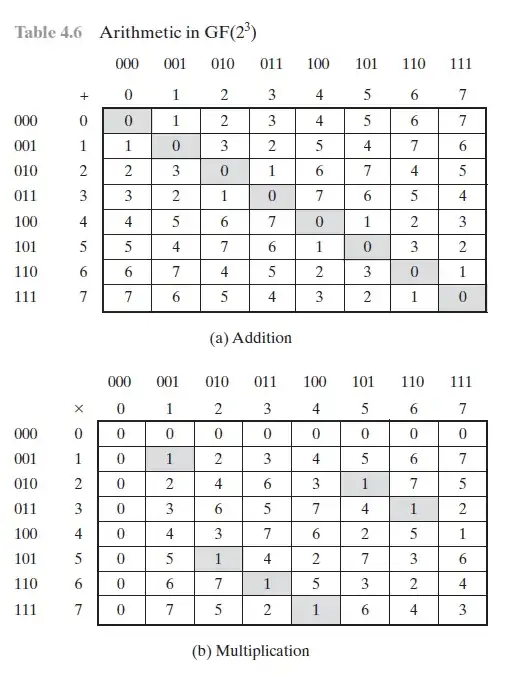I didn't undestand how this values, that are values in galois field $GF(2^{3})$. in thes below tables are obtained. Someone could explain me?

I didn't undestand how this values, that are values in galois field $GF(2^{3})$. in thes below tables are obtained. Someone could explain me?

The field is represented as a field of polynomials of degree $\leq2$ over the field $\mathbb F_2=\{0,1\}$. The notation $(cba)$ means $cX^2 + bX+a$. Since $1+1=0$ the addition table is clear, e.g. $(011)+(010)=(001)$.
For the multiplication, we need to find out what should $X^3$ be rewritten to. From the multiplication table you see that $X^3=X^2 \cdot X^1=(100)\cdot(010)=(011)$ and hence $X^3=X^1+1$ and therefore $X^4=X^2+X$. Now, you can multiply any two polynomials $(cba)\cdot(CBA)$ and rewrite them with degree $\leq2$.
Example: $$(111)\cdot(101)=(X^2+X+1)(X^2+1)=X^4+X^3+2X^2+X+1=X^4+X^3+0+X+1= (X^2+X)+(X+1)+X+1=X^2+X=(110).$$
In general, to find a representation of $\mathbb{GF}(p^n)$ you have to find a polynomial $f(X)$ of degree $n$ that is irreducible over $\mathbb F_p$. Irreducible means that if $f=gh$ for polynomials $g,h$, then either $g(X)=1$ or $h(X)=1$. Then you have that $\mathbb{GF}(p^n)\simeq \mathbb F[X]/f$.
Evidently, each element of the field is being represented in two different ways, as a string of $3$ bits, and as a number between $0$ and $7$, inclusive. The translation between the two representations is just that the $3$-bit string $abc$ corresponds to the number $4a+2b+c$; that is, we're just doing binary numbers here.
The addition is best understood by treating the $3$-bit strings as objects to be added without carry from one bit to the next. To put it another way, think of $abc$ as standing for the ordered triple $(a,b,c)$ and doing addition modulo $2$.
The multiplication is best understood by interpreting the $3$-bit string $abc$ as the polynomial $ax^2+bx+c$ and then doing multiplication modulo $2$ on the coefficients but also modulo $x^3+x+1$. That is, any time you get a power of $x$ higher than the second, you replace $x^3$ with $x+1$, and $x^4$ with $x^2+x$. Try it, you'll see how it works.